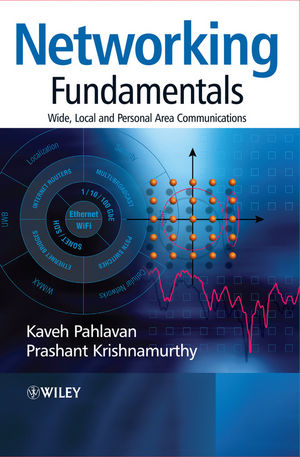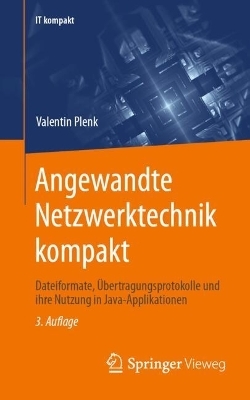
Networking Fundamentals
John Wiley & Sons Inc (Verlag)
978-0-470-99289-0 (ISBN)
- Titel z.Zt. nicht lieferbar
- Versandkostenfrei innerhalb Deutschlands
- Auch auf Rechnung
- Verfügbarkeit in der Filiale vor Ort prüfen
- Artikel merken
Focusing on the physical layer, Networking Fundamentals provides essential information on networking technologies that are used in both wired and wireless networks designed for local area networks (LANs) and wide-area networks (WANs). The book starts with an overview of telecommunications followed by four parts, each including several chapters. Part I explains the principles of design and analysis of information networks at the lowest layers. It concentrates on the characteristics of the transmission media, applied transmission and coding, and medium access control. Parts II and III are devoted to detailed descriptions of important WANs and LANs respectively with Part II describing the wired Ethernet and Internet as well as cellular networks while Part III covers popular wired LANs and wireless LANs (WLANs), as well as wireless personal area network (WPAN) technologies. Part IV concludes by examining security, localization and sensor networking. The partitioned structure of the book allows flexibility in teaching the material, encouraging the reader to grasp the more simple concepts and to build on these foundations when moving onto more complex information. Networking Fundamentals contains numerous illustrations, case studies and tables to supplement the text, as well as exercises with solutions at the end of each chapter. There is also a companion website with password protected solutions manual for instructors along with other useful resources.
Provides a unique holistic approach covering wireless communication technologies, wired technologies and networking
One of the first textbooks to integrate all aspects of information networks while placing an emphasis on the physical layer and systems engineering aspects
Contains numerous illustrations, case studies and tables to supplement the text, as well as exercises with solutions at the end of each chapter
Companion website with password protected solutions manual and other useful resources
Kaveh Pahlavan, is a Professor of Electrical and Computer Engineering (ECE), a Professor of Computer Science (CS), and Director of the Center for Wireless Information Network Studies, Worcester Polytechnic Institute (WPI), Worcester, MA. He is also a visiting Professor of Telecommunication Laboratory and CWC, University of Oulu, Finland. His area of research is location-aware broadband wireless indoor networks. He has contributed to numerous seminal technical publications and patents in this field. He is the principal author of the Wireless Information Networks (with Allen Levesque), John Wiley and Sons, 1995 and Principles of Wireless Networks -- A Unified Approach (with P. Krishnamurthy), Prentice Hall, 2002. He has been a consultant to a number of companies, including CNR Inc., GTE Laboratories, Steinbrecher Corp., Simplex, Mercury Computers, WINDATA, SieraComm, 3COM, and Codex/Motorola in Massachusetts; JPL, Savi Technologies, RadioLAN in California; Aironet in Ohio; United Technology Research Center in Connecticut; Honeywell in Arizona; Nokia, LK-Products, Elektrobit, TEKES, the Finnish Academy in Finland; and NTT in Japan. Before joining WPI, he was the director of advanced development at Infinite Inc., Andover, MA, working on data communications. He started his career as an assistant professor at Northeastern University, Boston, MA. He is the Editor-in-Chief of the International Journal on Wireless Information Networks. He was the founder, the program chairman, and organizer of the IEEE Wireless LAN Workshop, Worcester, in 1991 and 1996 and the organizer and technical program chairman of the IEEE International Symposium on Personal, Indoor, and Mobile Radio Communications, Boston, MA, 1992 and 1998. He has also been selected as a member of the Committee on Evolution of Untethered Communication, US National Research Council, 1997 and has led the US review team for the Finnish R&D Programs in Electronic and Telecommunication in 1999 and NETs project in 2003. For his contributions to the wireless networks he was the Westin Hadden Professor of Electrical and Computer Engineering at WPI during 1993--1996, was elected as a fellow of the IEEE in 1996 and became a fellow of Nokia in 1999. From May to December of 2000 he was the first Fulbright--Nokia scholar at the University of Oulu, Finland. Because of his inspiring visionary publications and his international conference activities for the growth of the wireless LAN industry, he is referred to as one of the founding fathers of the wireless LAN industry. In the past few years his research work has been the core for more than 25 patents by Skyhook Wireless, where he acts as the chief technical advisor. In January 2008 Steve Jobs announced that Skyhook Wireless’s WiFi localization technology is used in iPhone. Details of his contributions to this field are available at www.cwins.wpi.edu. Prashant Krishnamurthy is an associate professor with the graduate program in Telecommunications and Networking at the University of Pittsburgh. At Pitt, he regularly teaches courses on cryptography, network security, and wireless communications and networks. His research interests are wireless network security, wireless data networks, and position location in indoor wireless networks. He is the coauthor of the books Principles of Wireless Networks -- A Unified Approach and Physical Layer of Communication Systems and is a co-editor of Information Assurance: Dependability and Security in Networked Systems. He served as the chair of the IEEE Communications Society Pittsburgh Chapter from 2000 to 2005. He obtained his PhD from Worcester Polytechnic Institute, Worcester, MA, in 1999.
About the Authors xiii
Preface xv
1 Introduction to Information Networks 1
1.1 Introduction 1
1.1.1 Elements of Information Networks 3
1.1.2 Chronology of Information Networks 5
1.1.3 Standards Organizations for Information Networking 7
1.1.4 Evolution of Long-Haul Multiplexing Standards 10
1.2 Evolution of Wide-Area Networks 13
1.2.1 Evolution of the Public Switched Telephone Network 14
1.2.2 Emergence of the Internet 15
1.2.3 HFC Infrastructure for Cable TV 17
1.2.4 Evolution of Cellular Telephone Networks 17
1.3 Evolution of Local Networks 18
1.3.1 Evolution of Local Access to Public Switched Telephone Network 19
1.3.2 Evolution of the IEEE 802.3 Ethernet 21
1.3.3 Evolution of the IEEE 802.11 Wireless Local-Area Network 22
1.3.4 Internet Access to Home and IEEE 802.16 24
1.3.5 Evolution of IEEE 802.15 Wireless Personal-Area Networks 28
1.4 Structure of the Book 30
Questions 31
Project 1 32
Part One: Fundamentals of Transmission and Access 33
2 Characteristics of the Medium 35
2.1 Introduction 35
2.2 Guided Media 36
2.2.1 Twisted Pair 38
2.2.2 Coaxial Cables 42
2.2.3 Optical Fiber 45
2.3 Wireless Media 48
2.3.1 Radio Propagation Mechanisms 49
2.3.2 Path-Loss Modeling and Signal Coverage 50
2.3.3 Path-Loss Models for Indoor Areas 56
2.3.4 Path-Loss Models for Outdoor Areas 60
2.3.5 Effects of Multipath and Doppler 62
2.3.6 Emerging Channel Models 68
Questions 72
Problems 73
Project 1: Simulation of Multipath Fading 77
Project 2: The RSS in IEEE 802.11 78
Project 3: Coverage and Data Rate Performance of the IEEE 802.11B/G WLANs 79
3 Fundamentals of Physical Layer Transmission 83
3.1 Information Transmission 83
3.1.1 Wired and Wireless Transmission 84
3.1.2 Baseband Transmission 87
3.2 Transmission Techniques and Signal Constellation 89
3.2.1 Multisymbol Digital Communications 90
3.2.2 Signal Constellation in Digital Communications 91
3.2.3 Two-Dimensional Signal Constellations 94
3.2.4 Channel Capacity 100
3.3 Performance of the Physical Layer 102
3.3.1 Effects of Fading on Performance over Wireless Channels 105
3.3.2 Diversity Techniques 107
3.4 Wideband Modems 109
3.4.1 Spread-Spectrum Transmissions 110
3.4.2 Orthogonal Frequency-Division Multiplexing 115
3.4.3 Space–Time Coding 117
3.4.4 Capacity Multiple-Input–Multiple-Output Antenna Systems 118
Questions 119
Problems 120
Projects 123
4 Coding and Reliable Packet Transmission 125
4.1 Introduction 125
4.2 Source Coding and Framing Techniques 127
4.2.1 Information Source and Coding 127
4.2.2 Framing Techniques 130
4.3 FEC Coding 132
4.3.1 Fundamentals of Coding 132
4.3.2 Block Codes 136
4.3.3 Convolutional Codes 141
4.3.4 Codes for Manipulating Data 145
4.4 Coding for Spread-Spectrum and Code-Division Multiple Access Systems 147
4.4.1 Pseudo Noise Codes 148
4.4.2 M-ary Orthogonal Codes 149
4.5 ARQ Schemes 151
4.5.1 Stop and Wait 151
4.5.2 Go-Back-N 153
4.5.3 Selective-Repeat Automatic Repeat Request 153
4.5.4 Hybrid Automatic Repeat Request 154
4.6 Flow Control Protocols 155
4.6.1 Stop and Wait 156
4.6.2 Sliding Window 158
Questions 159
Problems 159
5 Medium Access Methods 165
5.1 Introduction 165
5.2 Centralized Assigned Access Schemes 167
5.2.1 Frequency-Division Multiple Access 168
5.2.2 Time-Division Multiple Access 171
5.2.3 Code-Division Multiple Access 174
5.2.4 Comparison of Code-, Time-, and Frequency-Division Multiple Access 177
5.2.5 Performance of Assigned Access Methods 180
5.3 Distributed Random Access Schemes 184
5.3.1 Random Access Methods for Data Services 184
5.3.2 Access Methods for Local-Area Networks 191
5.3.3 Performance of Random Access Methods 196
5.4 Integration of Voice and Data Traffic 205
5.4.1 Access Methods for Integrated Services 205
5.4.2 Data Integration in Voice-Oriented Networks 205
5.4.3 Voice Integration into Data-Oriented Networks 211
Questions 217
Problems 218
Projects 222
Part Two: Wide-Area Networks 225
6 The Internet 227
6.1 Introduction: Internet Infrastructure 227
6.1.1 Fundamentals of Packet Forwarding 229
6.2 Addressing 230
6.2.1 ISDN Addressing in Connection-Based PSTN 231
6.2.2 MAC Addressing in Connectionless Local-Area Networks 233
6.2.3 IP Addressing in the Connectionless Internet 235
6.3 Quality of Service 239
6.3.1 Quality of Service in Connection-Based Networks 240
6.3.2 Quality of Service in Connectionless Networks 241
6.4 Bridges 242
6.4.1 Standardization and Bridges 244
6.4.2 IEEE 802.1D Transparent Bridges 244
6.4.3 The Spanning-Tree Algorithm 246
6.4.4 IEEE 802.5 Source Routing Bridging 250
6.4.5 IEEE 802.1Q Virtual Local-Area Network 250
6.5 Switches 251
6.5.1 Circuit Switching in Public Switched Telephone Network 252
6.5.2 Integrated Service Data Network Switching 252
6.5.3 Packet Switching over Public Switched Telephone Network 253
6.5.4 Asynchronous Transfer Mode 254
6.6 Routers 260
6.6.1 Types of Router 262
6.6.2 Network Protocols for Routers 264
6.6.3 Routing Algorithms 269
6.6.4 Multiprotocol Label Switching 275
Questions 277
Problems 278
Project 1: Client-Server Programming 280
7 Cellular Networks 281
7.1 Introduction 282
7.1.1 The Cellular Concept 282
7.1.2 Cellular Hierarchy 285
7.2 General Architecture of a Cellular Network 286
7.2.1 Mobile Stations 288
7.2.2 The Base Station Subsystem 288
7.2.3 The Network and Switching Subsystem 289
7.3 Mechanisms to Support a Mobile Environment 290
7.3.1 Registration 290
7.3.2 Call Establishment 291
7.3.3 Handoff 293
7.3.4 Security 295
7.4 Protocol Stack in Cellular Networks 297
7.4.1 Layer 1: Physical Layer 298
7.4.2 Layer 2: Data Link Layer 299
7.4.3 Layer 3: Networking Layer 300
7.5 Physical Layer in TDMA Air Interface 302
7.5.1 Modulation Technique 302
7.5.2 Power and Power Control 304
7.5.3 Physical Packet Bursts 304
7.6 Physical Layer in CDMA Air Interface 310
7.6.1 CDMA Forward Channels 310
7.6.2 CDMA Reverse Channels 315
7.6.3 Packet and Frame Formats in a Typical CDMA Network 317
7.6.4 Other Variations in CDMA Air Interface 319
7.7 Achieving Higher Data Rates in Cellular Networks 320
7.7.1 Changes in Reference Architecture to Connect to Internet 321
7.7.2 How to Achieve High Data Rates 322
7.8 Deployment of Cellular Networks 325
7.8.1 Cell Fundamentals and Frequency Reuse 325
7.8.2 Capacity Expansion Techniques for Frequency-/Time-Division Multiple Access Systems 330
7.8.3 Network Planning for Code-Division Multiple Access Systems 335
Questions 337
Problems 338
Part Three: Local and Personal-Area Networks 343
8 IEEE 802.3 Ethernet 345
8.1 Introduction 345
8.2 Legacy Ethernet 349
8.2.1 The Packet Format and the Physical Layer 351
8.2.2 Carrier Sense Multiple Access with Collision Detection for the Medium Access Control Layer 352
8.2.3 Medium Access Control Performance 355
8.2.4 Alternatives to Legacy Ethernet 358
8.2.5 Early Enhancements to Legacy Ethernet 359
8.3 Evolution of the Physical Layer 361
8.3.1 Fast Ethernet at 100 Mb/s 361
8.3.2 Alternative for Fast Ethernet 368
8.3.3 Gigabit Ethernet 370
8.3.4 10 Gb/s Ethernet and Beyond 374
8.4 Emergence of Additional Features for Ethernet 379
8.4.1 Frame Format for the Virtual Local-Area Network 379
8.4.2 Full-Duplex Operation 381
8.4.3 PAUSE Frames 382
8.4.4 Link Aggregation 384
Questions 385
Problems 386
9 IEEE Wireless Local-Area Network Standards 389
9.1 Introduction 389
9.1.1 Early Experiences 390
9.1.2 Emergence of Unlicensed Bands 391
9.1.3 Products, Bands, and Standards 392
9.1.4 Shift in Marketing Strategy 393
9.2 IEEE 802.11 and WLANs 395
9.2.1 Overview of IEEE 802.11 396
9.2.2 IEEE 802.11 Wireless Local-Area Network Operations 398
9.2.3 The IEEE 802.11 Medium Access Control Layer 402
9.2.4 The Physical Layer 410
9.2.5 Deployment of Wireless Local-Area Networks 419
9.2.6 Security Issues and Implementation in IEEE 802.11 425
9.2.7 Wireless Local-Area Network Standards and 802.11 Standards Activities 428
9.3 IEEE 802.16 (WiMAX) 430
9.3.1 General Architecture 432
9.3.2 Physical Layer 433
9.3.3 Medium Access Control Layer of WiMAX 434
Questions 435
Problems 436
Projects 441
10 IEEE 802.15 Wireless Personal-Area Network 443
10.1 Introduction 443
10.1.1 IEEE 802.15 Wireless Personal-Area Network Standardization Series 444
10.2 IEEE 802.15.1 Bluetooth 445
10.2.1 Overall Architecture 447
10.2.2 Protocol Stack 448
10.2.3 Physical Connection 450
10.2.4 Medium Access Control Mechanism 452
10.2.5 Frame Formats 452
10.2.6 Connection Management 458
10.2.7 Security 460
10.3 Interference between Bluetooth and 802.11 460
10.3.1 Interference Range 461
10.3.2 Probability of Interference 465
10.3.3 Empirical Results 468
10.4 IEEE 802.15.3A Ultra Wideband Wireless Personal-Area Networks 470
10.4.1 Direct Sequence Ultra Wideband 470
10.4.2 Multiband Orthogonal Frequency-Division Multiplexing 474
10.5 IEEE 802.15.4 ZigBee 477
10.5.1 Overall Architecture 478
10.5.2 Protocol Stack 479
10.5.3 Medium Access Control Layer 480
10.5.4 Physical Layer 481
10.5.5 Frame Format 483
10.5.6 Comparison of ZigBee with Bluetooth and WiFi 484
Questions 485
Problems 486
Part Four: System Aspects 489
11 Network Security 491
11.1 Introduction 491
11.2 Network Attacks and Security Issues 492
11.2.1 Network Communications 492
11.2.2 Why Security Attacks are Possible 494
11.2.3 Some Example Security Attacks 498
11.2.4 Defining Security Attacks, Services, and Architecture 504
11.3 Protection and Prevention 505
11.3.1 Firewalls and Perimeter Security 505
11.3.2 Cryptography and Cryptographic Protocols 508
11.3.3 Preventing Successful Phishing Attacks 523
11.4 Detection 523
11.5 Assessment and Response 524
Questions 526
Problems 526
Projects 528
12 Wireless Localization 529
12.1 Introduction 529
12.2 What is Wireless Geolocation? 530
12.2.1 Wireless Emergency Services 532
12.2.2 Performance Measures for Geolocation Systems 533
12.3 Radio-Frequency Location Sensing and Positioning Methodologies 534
12.3.1 Generic Architecture 534
12.3.2 Positioning Algorithms 536
12.3.3 Positioning Standards for Cellular Telephone Systems 544
12.4 LCS Architecture for Cellular Systems 546
12.4.1 Cellular Network Architecture 548
12.4.2 Location Services Architecture 549
12.4.3 Over the Air (Access Network) Communications for Location Services 551
12.4.4 Signaling in the Fixed Infrastructure (Core Network) for Location Services 552
12.4.5 The Mobile Location Protocol 553
12.5 Positioning in Ad Hoc and Sensor Networks 554
Questions 555
Problems 556
Projects 556
13 Wireless Sensor Networks 559
13.1 Introduction 559
13.2 Sensor Network Applications 560
13.2.1 Habitat Monitoring 560
13.2.2 Structural Health Monitoring 561
13.2.3 Miscellaneous Applications 561
13.3 Sensor Network Architecture and Sensor Devices 561
13.3.1 Sensor Network Architecture 562
13.3.2 Overview of Sensor Devices 564
13.3.3 Commercial Sensors 566
13.3.4 Future Directions 568
13.4 The Physical Layer in Sensor Networks 570
13.4.1 Spectrum 570
13.4.2 Path Loss 571
13.4.3 Gray Zone 572
13.4.4 Modulation Schemes 573
13.5 The MAC Layer in Sensor Networks 574
13.5.1 Issues in Medium Access for Sensor Networks 575
13.5.2 IEEE 802.15.4 Medium Access Control 577
13.5.3 Low-Duty-Cycle Medium Access Controls 578
13.5.4 Low-Latency Medium Access Controls 579
13.6 Higher Layer Issues in Sensor Networks 580
13.6.1 Establishing the Sensor Network 581
13.6.2 Routing 583
13.6.3 Coverage, Connectivity, and Topology Control 585
13.6.4 Synchronization 587
13.6.5 Security 588
Questions 591
References 593
Appendix A: What is Decibel? 605
Appendix B: STC for Two Transmitters and One Receiver 607
Appendix C: Source Coding 611
C.1 Source Coding for Voice 611
C.2 Source Coding for Images and Video 613
Appendix D: Acronyms 615
Appendix E: List of Variables 627
Index 633
| Verlagsort | New York |
|---|---|
| Sprache | englisch |
| Maße | 172 x 250 mm |
| Gewicht | 1270 g |
| Themenwelt | Mathematik / Informatik ► Informatik ► Netzwerke |
| Technik ► Elektrotechnik / Energietechnik | |
| Technik ► Nachrichtentechnik | |
| ISBN-10 | 0-470-99289-1 / 0470992891 |
| ISBN-13 | 978-0-470-99289-0 / 9780470992890 |
| Zustand | Neuware |
| Haben Sie eine Frage zum Produkt? |
aus dem Bereich


